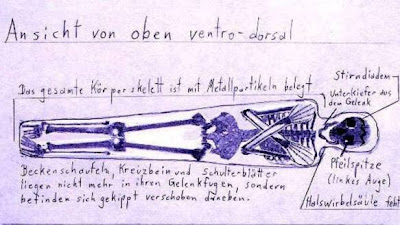Thursday, September 5, 2013
FORENSICS REVEAL GERMAN ATTIC MUMMY
HAS ARROWHEAD IN EYE SOCKET
HAS ARROWHEAD IN EYE SOCKET
THE mystery of an Egyptian mummy discovered in a homeowner's attic in Germany has become even more baffling after an X-ray revealed an arrowhead lodged in the left eye socket.
The X-ray also showed a diadem around the forehead of the skull. The skull itself is detached from the rest of the skeleton because there are no neck vertebrae.
The arms are dislocated from the shoulders and there are strange "metal particles" covering the entire skeleton, according to the X-ray image (above).
The GERMAN ATTIC MUMMY made headlines around the world a month ago when a 10-year-old boy was playing in his late grandparents' attic in the hamlet of Diepholz and pulled away a wall panel which revealed a hidden chamber containing an ornate Egyptian coffin and boxes containing a Canopic jar and a replica Egyptian head.
Experts quickly determined that the coffin was not of dynastic origin, but rather a 20th Century mock-up. For one thing, the coffin decorations were imitations of wall murals from the Tomb of Tutankhamun, which was not discovered until 1922.
And the mummy bandages are factory woven 20th Century gauze, experts says.
Initial X-rays revealed human bones ... though it is unclear whether the bones are all from one individual or whether some ingenious fraudster simply arranged a variety of bones under the wrappings to give the outline of a body.
Most intriguing of all is the revelation that the skull has an arrowhead lodged in one eye socket.
The mummy has now been transported to Hamburg to undergo thorough police forensic tests. The coffin is also undergoing analysis to determine its age and origin.
"I couldn't believe my eyes when I opened it and saw a genuine mummy, exactly 1.60 meters long (5 ft, 3 in), and the interior of the case artistically worked out in hieroglyphs," says Lutz Wolfgang Kettler, a 53-year-old dentist.
His 10-year-old son Alexander was poking around the dusty attic when he noticed some loose boards on a wall panel.
Like a young Indiana Jones, he sensed there might be something behind them ... and sure enough there was.
How did these strange crates end up in the northern German hamlet of Diepholz?
Kettler says it all may have started over half a century ago in Egypt: "My father, who died 10 years ago, traveled to Egypt in the 1950s. Unfortunately, he never told us much about it ... except that he had to go to the port of Bremerhaven to get something through customs. I'm afraid there aren't any documents on what it was."
The secret died with his father.
"Nobody in the family ever suspected there was a mummy in the attic."
The Egyptians have a long history of selling mummies to foreigners. Every European aristocrat wanted a mummy in their stately home. And "mummy dust" from ground-up mummies was believed to be a curative for a vast array of ailments aimed at prolonging life.
In some cases, genuine ancient mummies have been sold to travelers, and many of the mummies now in museums around the world were bought from mummy vendors in Egypt, as depicted in this vintage photo.
But very often, fake mummies have been foisted onto gullible tourists over the centuries.
Oftentimes the elaborate wrappings conceal animal bones arranged to resemble the form of a human skeleton.
Other times ... and despite Islamic abhorrance of desecrating the dead ... human corpses were hastily eviscerated and haphazardly mummified and sold to foreigners.
Through the centuries, it has been a neat way of disposing of unwanted corpses ... eliminating the corpus delicti without anyone being the wiser. This ploy has been a frequent plot device in countless novels and movies.
So it will be interesting to see what those mummy wrappings reveal ....
Labels:
ancient egypt,
antinoo,
antinoos,
antinous,
archaeology,
archeology,
art,
mummies,
mummy
Subscribe to:
Post Comments (Atom)




No comments:
Post a Comment